Glassware Market Research, 2031
The global glassware market size was valued at $15.2 billion in 2021 and is projected to reach $25.4 billion by 2031, growing at a CAGR of 5.2% from 2022 to 2031.Glassware is made up of various types of glasses such as soda lime glass, crystal glass, borosilicate glass, and heat-resistant glass. Different types of glassware are used to serve drinks and food in the food service industry and in households. There are different types of attractive and stylish glassware offered by manufacturers in the market.
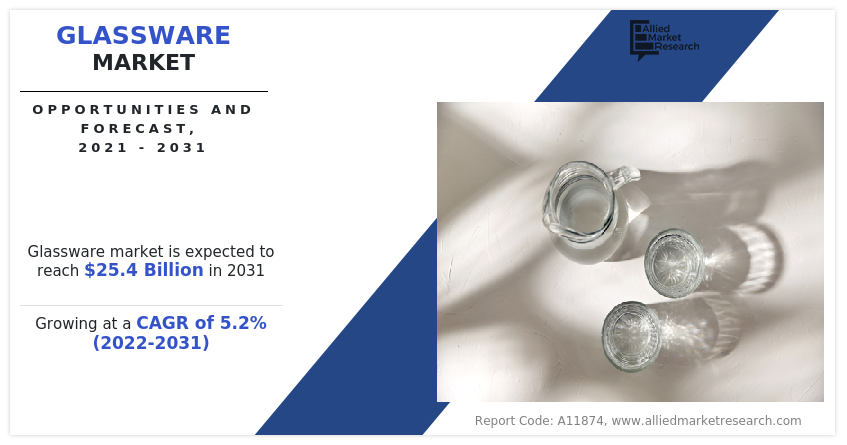
An increase in investment and business expansion in the food service industry is expected to create more opportunities for the key market players to develop or launch innovative products in the market to cater to the increasing demand. The key market players in the hospitality sectors are increasingly investing in the food service industry to expand the hotel and restaurant business. Globally, tourism has boosted the hotel and restaurant industry's business and offered a lot of opportunities to the key players in the market. The hotel and restaurants have expanded mostly owing to tourism and since different countries' diverse landscapes, cultures, and societies were very appealing to tourists from other regions. The hotel and restaurant sectors of many nations have gradually expanded over the last two decades which is expected to propel the growth of the glassware industry in upcoming years.
A fine dining restaurant is a specialty or a multi-cuisine eatery that prioritizes superior ingredients, artistic presentation, and attentive service. With the increase in spending on fine dining, the demand for glassware is increasing from the hotel and restaurants which is expected to create more opportunities for the key manufacturers in the market. The fine dining category is increasing at a respectable pace of 15%, which has encouraged the arrival of premium Michelin-starred restaurants and other local competitors which use glassware for the artistic presentation of the food and beverages which attract the consumer's attention. Therefore, the growing demand for fine delicate dining is mainly accomplished by the successful operations of different types of brands of glassware products in hotels and restaurants. The rising popularity of fine dining across the globe is expected to propel the glassware market growth.
Online retail platform is the major driver for the global market. Presently, numerous retailers are associating or have their own web-based retail stores where consumers can gain information about manufacturers and their products. An increase has been witnessed in the number of online shoppers, owing to the availability of varied product options and price comparison on online shopping sites. This is useful for retailers due to zero expenditure on physical outlets or stores. One of the major reasons behind consumers preferring online shopping online is that they can read reviews provided by other users, and compare various stores, products, and prices by different sellers which is expected to fuel the glassware market demand. Furthermore, an increase in e-commerce sales, improvement in logistics services, ease in payment options, and the facility to enter new international markets by major brands significantly contribute toward the glassware market growth.
With the increasing demand for glassware, the manufacturers are focusing on research and development to offer cost-efficient and durable glassware which is the requirement of the customers. Research and technology are constantly refined and improved through technical innovation, from less durable, but cleaner products to more efficient manufacturing methods. Researchers and designers at organizations work to enhance product features by developing newer, cutting-edge designs, forms, colors, and functionality that encourage customers to buy the products. The ongoing glassware market trends is expected to create opportunities for manufacturers in the upcoming years. Research and development teams are performed various research from raw materials to finished products. They intend to develop sustainable products in the market in a long run. technical innovation in glassware manufacturing is expected to create opportunities for the manufacturers during the glassware market forecast.
The global glassware industry is impacted profoundly by the outbreak coronavirus. The demand for glassware is expected to slightly taper across the world, owing to supply chain disruptions and the implementation of stringent restrictions to follow social distancing & consistent lockdowns across the globe.
There are different types of raw materials are used in glassware production. Fluctuating prices of raw materials will impact the cash flows and earnings of companies in the ecosystem which is resulted in a higher price of end products. Manufacturers are facing the challenge of increasing prices of raw materials in the process of glass manufacturing. Fuels used by the industry (HFO and NG), soda ash, packing material, freight, manpower, electricity costs, etc. have taken a huge toll on the margins of the industry. Soda ash, being one of the key raw materials for glass manufacturing is largely imported from Romania, U.S., Bulgaria, and Kenya. The rise in prices of raw materials, power, and fuel, as changes in government policies about employees, will have an impact on the total expense and the cost of production. With the increasing demand for glassware from different regions, manufacturers are facing a raw material shortage which is resulted in an increase in raw material prices. Low durability and the higher cost of glassware are expected to hinder the growth of the market. Lack of awareness regarding the glassware product may challenge the growth of the market during the forecast period.
According to the market analysis, the global glassware market is segmented into material, product type, price point, end user, distribution channel, and region. Based on material, the market is divided into soda lime glass, crystal glass, borosilicate glass, and heat resistant glass. By product type, the market is divided into tea cup, coffee mug, wine glass, everyday glass, spirit glass, beer mug, pitchers, glass jars, and others. As per price point, the market is divided into premium, medium, and economy. Based on end user, the market is divided into households, hotels and restaurants, corporate canteens, café and bars, and others. By distribution channel, the market is classified into hypermarkets and supermarkets, specialized stores, online retail, and others. Region-wise, the market is analyzed across North America (the U.S., Canada, and Mexico), Europe (Germany, France, Italy, Spain, UK, Russia, and rest of Europe), Asia-Pacific (China, Japan, India, South Korea, Australia, Thailand, Malaysia, Indonesia, and rest of Asia-Pacific), and LAMEA (Brazil, South Africa, Saudi Arabia, UAE, Argentina, and rest of LAMEA).
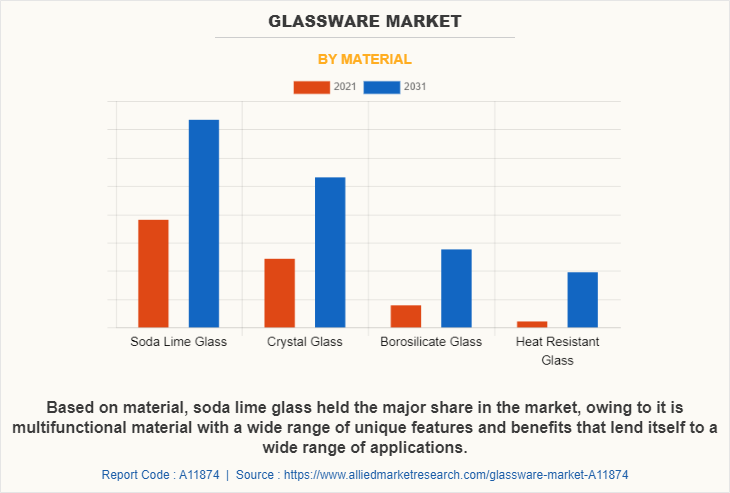
The Soda Lime Glass segment accounted for more than 30% of the glassware market share, in terms of revenue, in 2021 as it is being widely used in glassware production Soda lime glass is characterized by the greenish tinge from which it gets its name. It is a low-cost, transparent float glass. It is simple to manufacture and widely used in the production of different types of glassware. Soda lime glass is produced by floating the material over the molten tin, where it softens and solidifies into glass sheets. Soda lime glass is a multifunctional material with a wide range of unique features and benefits that lend itself to a wide range of applications. The different applications of soda lime glass create more opportunities for manufacturers to offer various types of glassware which are expected to propel the market growth during the glassware market forecast.
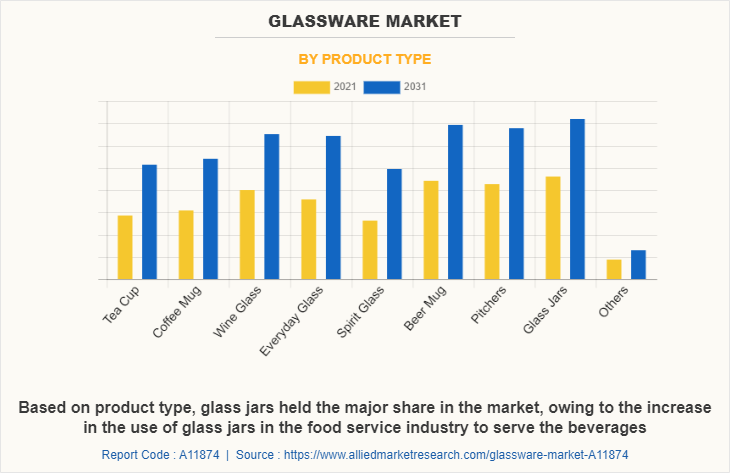
By product type, the glassware market is categorized into teacup, coffee mug, wine glass, everyday glass, spirit glass, beer mug, pitchers, glass jars, and others. The glass jars segment led the market and accounted for 15.2% of the global glassware market size in 2021 and is expected to maintain its dominance during the forecast period. Glass jars are commonly used to store beverages and food. Glass jars are made up of crystal and soda lime glass material which gives strength to the glass jar. Glass jars are widely used in the food service industry to the preserve and serve the drinks and protect them from outside contamination. There are different types of glass jars are offered by the manufacturer for different available in the market. With the changing consumer lifestyles and shift in consumption patterns regarding drinking beverages, the demand for decorative glassware from the food service industry is increasing day by day. Glass jars keep air and other liquids out, and glass jars never impair the flavor or freshness of the product. Furthermore, glass jars are widely used in hotels, restaurants, and café as decorative glass containers to serve drinks which are expected to propel the growth of the glassware market during the forecast period.
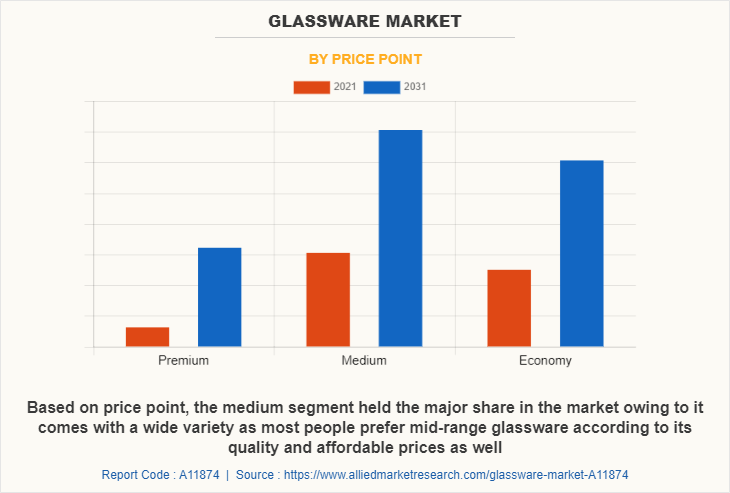
By price point, the glassware market is categorized into premium, medium, and economy. The glass jars segment led the market and accounted for 39.9% of the global glassware market in 2021 and is expected to maintain its dominance during the forecast period. Mid-range glassware has a collection of different glass products as most consumers prefer mid-range products that are good in quality and slightly inexpensive. As most consumers are mid-range buyers, this segment offers many products to attract the population. Moreover, the mid-range is the only section that every glassware manufacturing brand and company targets as it generates most of the revenue. The e-commerce sector also plays a major role in the segment as it provides large varieties of glassware products at affordable prices.
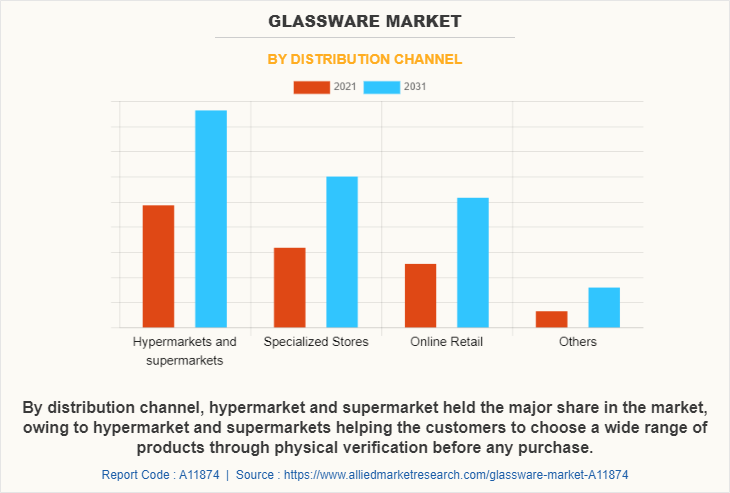
By distribution channel, the glassware market is segmented into hypermarkets and supermarkets, specialized stores, online retail, and others. The hypermarkets and supermarkets segment led the market and accounted for a 38.7% glassware market share. Hypermarkets & supermarkets are large stores that operate on a self-service basis, selling large varieties of glassware products, home appliances, groceries, fresh produce, food & beverage products, and sometimes an assortment of non-food goods as well. Customers are inclined toward buying glass products from the supermarket and hypermarkets, to find out perfect products as well as durable products. Furthermore, this group is attributed to the easy and wide availability of glass products in the supermarket and hypermarkets.
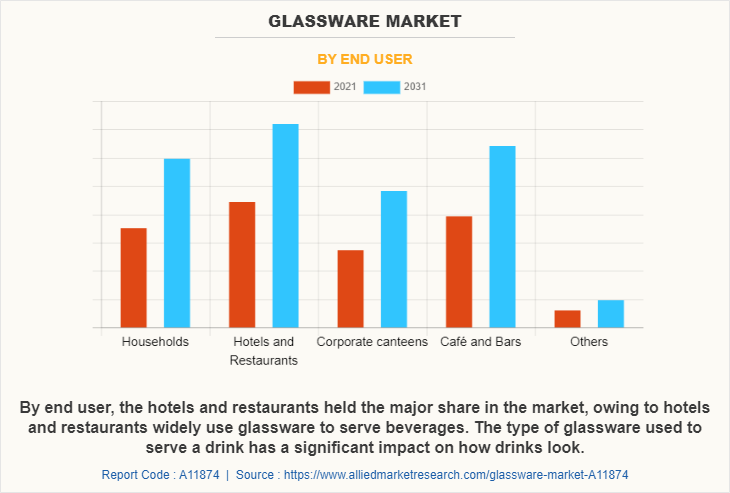
By end user, the glassware market is categorized into households, hotels and restaurants, corporate canteens, café and bars, and others. The hotels and restaurants segment led the market and accounted for a 29.2% share of the market. Hotels and restaurants use different types of glassware such as wine glass, everyday glass, spirit glass, beer mugs, pitchers, food jars, and others to serve the food and beverages to the consumers. The type of glassware used to serve a drink which has a significant impact on how drinks look. Some of the hotels are now serving a variety of drinks in custom-designed glasses to gain the attraction of consumers.
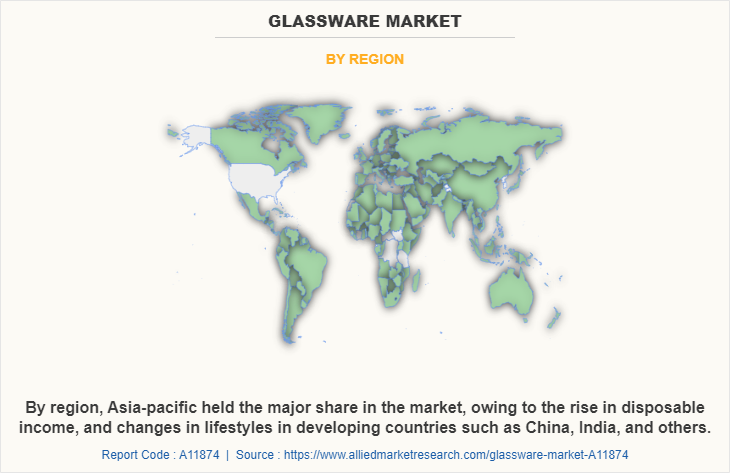
Region-wise, Asia-Pacific was the largest market in 2021 and had the highest market share of 33.1%. The sales of glassware by end-user are increasing at a significant rate in Asia-pacific, owing to the rise in disposable income, and changes in lifestyles in developing countries such as China, India, and others. In Asia-Pacific, China is the largest producer of glassware which is the leading driver for the Asia-Pacific market. The demand for glassware is growing rapidly in the food service industry as well as in households. With the increase in demand for glassware, manufacturers in the Asia-Pacific region are investing in research and development to develop cost-effective and durable glassware.
The players in the glassware market have adopted acquisition, business expansion, partnership, collaboration, and product launch as their key development strategies to increase profitability and improve their position in the glassware market.
Some of the key players profiled in the glassware market analysis include Anchor Hocking Group, Inc, Anhui Deli daily Glass Co., Ltd, Arc Online, Borosil Limited, Degrenne, Garbo Glassware, Glass Tech Life, Guangzhou Jing Huang Glassware Co,Ltd, Lenox Corporation, Libbey Glass LLC, Lifetime Brands, Inc, Ocean Glass Public Company Limited, Shandong Huapeng Glass Co., Ltd., Sisecam, Steelite International, Taiwan Glass Industry Corporation, Villeroy & Boch AG, and Zrike Brands.
Key Benefits for Stakeholders
- This report provides a quantitative analysis of the market segments, current trends, estimations, and dynamics of the market analysis from 2021 to 2031 to identify the prevailing glassware market opportunities
The market research is offered along with information related to key drivers, restraints, and opportunities
Porter's five forces analysis highlights the potency of buyers and suppliers to enable stakeholders make profit-oriented business decisions and strengthen their supplier-buyer network
In-depth analysis of the glassware market segmentation assists to determine the prevailing market opportunities
Major countries in each region are mapped according to their revenue contribution to the global market
Market player positioning facilitates benchmarking and provides a clear understanding of the present position of the market players
The report includes the analysis of the regional as well as global glassware market trends, key players, market segments, application areas, and market growth strategies
Glassware Market Report Highlights
| Aspects | Details |
| Market Size By 2031 | USD 25.4 billion |
| Growth Rate | CAGR of 5.2% |
| Forecast period | 2021 - 2031 |
| Report Pages | 400 |
| By Material |
|
| By Product Type |
|
| By Price Point |
|
| By Distribution Channel |
|
| By End User |
|
| By Region |
|
| Key Market Players | Borosil Limited, Lenox Corporation, Garbo Glassware, Libbey Glass LLC, Shandong Huapeng Glass Co., Ltd., Anchor Hocking Group, Inc, Degrenne, Ocean Glass Public Company Limited, Anhui Deli daily Glass Co., Ltd, Guangzhou Jing Huang Glassware Co,Ltd, Steelite International, Zrike Brands, Villeroy & Boch AG, Taiwan Glass Industry Corporation, Glass Tech Life, Lifetime Brands, Inc, Arc Online, Sisecam |
Analyst Review
According to the insights of CXOs of leading companies, the glassware market holds a substantial scope for growth; however, its contribution to the world market would increase significantly within the next six years. Glassware is versatile as they are used in, hotels and restaurants, corporate canteens, café and bars, and others. However, recent innovations and development in glassware production are expected to create new opportunities in this booming sector. Several players are entering the market with innovative designs, cost-effective products, and durable products which are expected to fuel the growth of the market. Moreover, the increase in investment in the food service industry is expected to create opportunities for glassware manufacturers in the upcoming years.
The global glassware market size was valued at $1,5180 million in 2021 and is projected to reach $2,5345.6 million by 2031, registering a CAGR of 5.2% from 2022 to 2031.
The global glassware market is segmented into material, product type, price point, end user, distribution channel and region. Based on material, the market is divided into soda lime glass, crystal glass, borosilicate glass, and heat resistant glass. By product type, the market is divided into tea cup, coffee mug, wine glass, everyday glass, spirit glass, beer mug, pitchers, glass jars, and others. As per price point, the market is divided into premium, medium, and economy. Based on end user, the market is divided into households, hotels and restaurants, corporate canteens, café and bars, and others. By distribution channel, the market is classified into hypermarkets and supermarkets, specialized stores, online retail, and others. Region-wise, the market is analyzed across North America (the U.S., Canada, and Mexico), Europe (Germany, France, Italy, Spain, UK, Russia, and rest of Europe), Asia-Pacific (China, Japan, India, South Korea, Australia, Thailand, Malaysia, Indonesia, and rest of Asia-Pacific), and LAMEA (Brazil, South Africa, Saudi Arabia, UAE, Argentina, and rest of LAMEA).
Asia-Pacific
The major players analyzed for the glassware market are Anchor Hocking Group, Inc, Anhui Deli daily Glass Co., Ltd, Arc Online, Borosil Limited, Degrenne, Garbo Glassware, Glass Tech Life, Guangzhou Jing Huang Glassware Co,Ltd, Lenox Corporation, Libbey Glass LLC, Lifetime Brands, Inc, Ocean Glass Public Company Limited, Shandong Huapeng Glass Co., Ltd., Sisecam, Steelite International, Taiwan Glass Industry Corporation, Villeroy & Boch AG, and Zrike Brands.
The global glassware market report is available on request on the website of Allied Market Research.
The forecast period considered in the global glassware market report is from 2022 to 2031. The report analyzes the market sizes from 2022 to 2031 along with the upcoming market trends and opportunities. The report also covers the key strategies adopted by the key players operating in the market.
The base year calculated in the glassware market report is 2021.
Loading Table Of Content...


